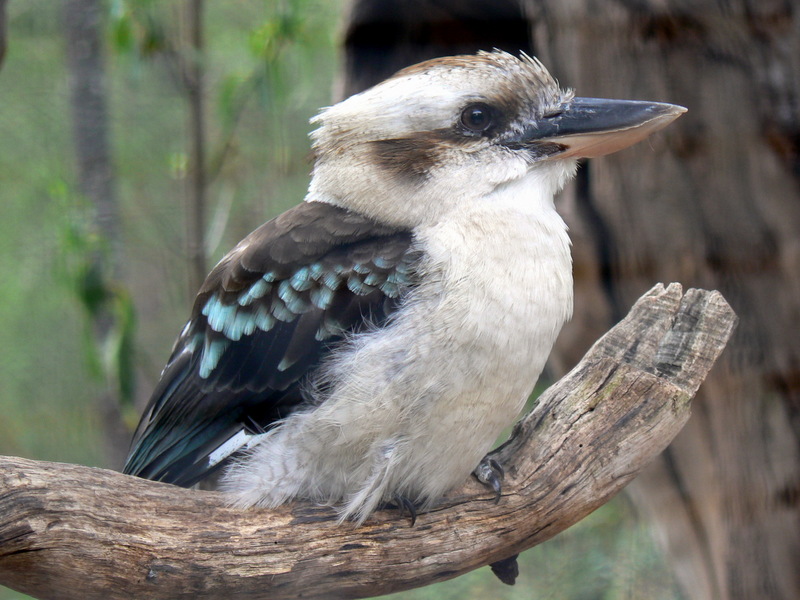ERROR : Server Busy(-1105)
ERROR : Server Busy(-1105)
Laughing Kookaburra (Dacelo novaeguineae) - Wiki
Laughing Kookaburra
From Wikipedia, the free encyclopedia
[Photo] Laughing Kookaburra. Taken at Healesville Sanctuary, Victoria Australia. Date 8/2/2007 3:49 PM AEST. Author Dushy
The Laughing Kookaburra, Dacelo novaeguineae, is a familiar Australian carnivorous bird of the Kingfisher family, well known for its call. Previously known as the Laughing Jackass it is now best known by its aboriginal name.
Distribution
It is found throughout eastern Australia, and has been introduced into the south-west corner of Western Australia, Tasmania, Flinders Island, Kangaroo Island.
Furthermore, some were also introduced into New Zealand between 1866 and 1880, but only those liberated on Kawau Island by Sir George Grey survived. Descendants are still found there today.
Description
The Laughing Kookaburra is a handsome, stocky bird of about 45 cm in length, with a large head, a prominent brown eye, and a very large bill. The male can be easily distinguished from the female by the blue hues on his wing feathers and darker blue on his tail feathers. The female on the other hand has a small amount of aqua on her wing feathers, but no blue on her tail feathers.
Ecology and behaviour
Kookaburras occupy woodland territories (including forests) in loose family groups, and their laughter serves the same purpose as a great many other bird calls -- to demarcate territorial borders.
Call
The "Laughing Kookaburra" is known by its name for its "laugh" which it uses to greet its mate after periods of absences. It can be heard at any time of day but most frequently shortly after dawn and especially when the colour drains from the forest after sunset.
One bird starts with a low, hiccupping chuckle, then throws its head back in raucous laughter: often several others join in. If a rival tribe is within earshot and replies, the whole family soon gathers to fill the bush with ringing laughter. Hearing kookaburras in full voice is one of the more extraordinary experiences of the Australian bush, something even locals cannot ignore; some visitors, unless forewarned, may find their call startling.
Diet
Kookaburras hunt much as other kingfishers (or indeed Australasian robins) do: by perching on a convenient branch or wire and waiting patiently for prey to pass by: mice and similar-sized small mammals, large insects, lizards, small birds and nestlings, and most famously, snakes. Small prey are preferred, but not infrequently do kookaburras take surprisingly large creatures, including venomous snakes a good deal longer than the bird itself.
Life
Most species of Kookaburra tend to live in family units, with offspring helping the parents hunt and care for the next generation of offspring.
During mating season, the Laughing Kookaburra indulges in behaviour similar to that of a Wattle Bird. The female adopts a begging posture and vocalises like a young bird. The male then offers her his current catch accompanied with an "oo oo oo" sound. They start breeding around October/November. If the first clutch fails, they will continue breeding into the summer months.
They generally lay three eggs at about 2 day intervals. If the food supply is not adequate the third egg will be smaller and the third chick will also be smaller and at a disadvantage to its larger siblings. Chicks have a hook on the upper mandible, which disappears by the time of fledging. If the food supply to the chicks is not adequate the chicks will quarrel and the hook can be used as a weapon and the smallest chick can be killed by its larger siblings. If food is plentiful the parent birds spend more time brooding the chicks and so the chicks are not able to fight.
Interaction with humans
The Laughing Kookaburra are a common sight in suburban gardens and urban settings, even in quite built up areas, and are so accustomed to humans that they will quite often eat out of their hands. People often fed them pieces of raw meat and gristle. It is not recommended to feed them however as it interferes with their basic dietary requirements and can lead to disease.
http://en.wikipedia.org/wiki/Laughing_Kookaburra
| The text in this page is based on the copyrighted Wikipedia article shown in above URL. It is used under the GNU Free Documentation License. You may redistribute it, verbatim or modified, providing that you comply with the terms of the GFDL. |
|

